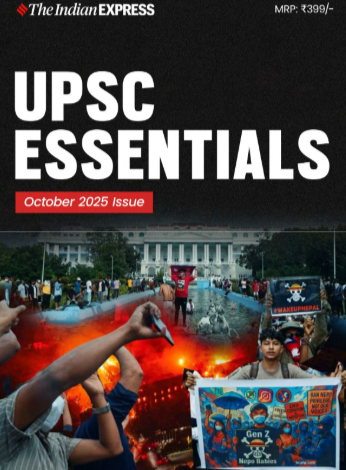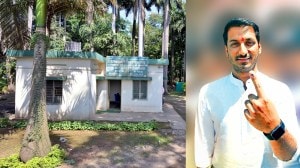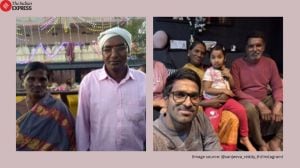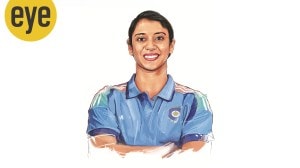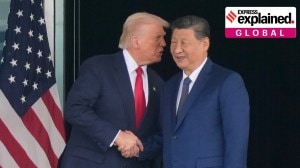
Syllabus:
Preliminary Examination: Current events of national and international importance
Mains Examination: General Studies-II: Effect of policies and politics of developed and developing countries on India’s interests, Indian diaspora
Story continues below this ad
What’s the ongoing story: After Hamas released all 20 of the remaining living Israeli hostages as part of President Trump’s peace plan to end the war in Gaza, world leaders signed Gaza peace deal in Egypt and former US Presidents Joe Biden and Bill Clinton praised President Trump’s efforts to broker a ceasefire in war ravaged Gaza.
Key Points to Ponder:
— What is the 20-point Gaza ceasefire agreement?
— What are the challenges in the fulfillment of the Gaza ceasefire agreement?
— What is India’s reaction to this agreement?
— What are India’s interests in the region?
— What is the International Stabilisation Force (ISF)?
— Understand the historical background of India’s relationship with Israel and Palestine
Key Takeaways:
— Israel and Hamas moved ahead on a key first step in the 20-point Gaza ceasefire agreement signed last week in Egypt during indirect talks and freed hostages and prisoners on Monday, raising hopes that the US-brokered deal could pave the way for ending the two year old war permanently that has ravaged the Palestinian territory.
Story continues below this ad
— For Israelis, the return of 20 living hostages brought elation and a sense of closure to a war that many feel was forced on the country due to Hamas’ terror attack on October 7, 2023 which killed over 1,200 people and the militant group abducted 251 people to Gaza. Though many in Israel have pledged to keep the fighting on in for the return of deceased hostages still in Gaza.
— President Donald Trump called for a new era of harmony in the Middle East on Monday during a global summit on Gaza’s future, trying to advance broader peace in the region after visiting Israel to celebrate a US-brokered ceasefire with Hamas.
— The US, along with Egypt, Qatar and Turkey, mediated what has been described as a first phase agreement between Israel and Hamas for a ceasefire and the release of hostages by Hamas and prisoners and de-tainees by Israel.
— Trump arrived in the Egyptian beach resort of Sharm el-Sheikh about an hour before sundown for the gathering of more than 20 world leaders, which he was to chair alongside President Abdel Fattah al-Sisi.
Story continues below this ad
— Egyptian President Abdel Fattah El-Sisi has decided to award US President Donald Trump the country’s highest honor, the Order of the Nile, in recognition of his “distinguished contributions to supporting peace efforts, defusing conflicts, and most recently, his pivotal role in ending the war in Gaza”.
— Among the several issues left to resolve in the Gaza ceasefire agreement, one of the most difficult remains Israel’s insistence that a weakened Hamas disarm and it depends on Israeli military’s full withdrawal from the Gaza territory.
— Hamas has refused to fully disarm and the militant groups want to ensure that Israel withdraws from Palestine completely, leaving some room for Netanyahu to say that Israel still has some room to resume fighting.
EXPLAINED: After Sharm El-Sheikh: easy part over, peace plan test begins
Story continues below this ad
— The big questions, though, are if this truce will continue to hold and what comes next. An agreement is yet to be reached on Gaza’s post war governance and the territory’s reconstruction.
— There are multiple stumbling blocks. The hostage exchange was point number one in Trump’s 20-point plan, literally signalling the first phase of the initiative. The heavy-lifting was to come after this, including issues such as the disarming of Hamas, the security guarantee for Gaza and the far bigger task of rebuilding the enclave, which is pretty much a demolition site now.
— And even if all this is done, the bigger question is: who will govern Gaza, if not the Hamas or the Palestinian Authority, as has been suggested in the deal. There’s one vague reference to Palestinian statehood, but no tangible commitment to that in the text that follows.
— At the heart of this conflict is the question of occupation and the denial to one of the parties to the conflict to even participate in the building of a peace plan. That issue is unaddressed. The Palestinians have had no voice in this peace plan; they were not even at the table.
Story continues below this ad
— The basic questions that are at the heart of this enduring conflict have been ignored largely in Trump’s so-called peace plan. And that’s the issue of the occupation of the Palestinian territories by Israel, and the inability, or the refusal, of the international community to deal with that fundamental subject.
— The international stabilisation forces in Trump’s plan, which are supposed to consist of Arab and Muslim states, is unlikely to make a dent without Hamas agreeing to disarm and allowing this force to come in.
Do You Know:
— Nicolas Blarel and Sumit Ganguly wrote: India has welcomed the plan with PM Narendra Modi, too, describing it as “decisive progress” and a “significant step forward”. Israel’s envoy to India said that it should carry out reconstruction activities, given its expertise in important infrastructural projects and its good relations with both Israel and the PA.
— However, since October 7, 2023, India’s official position on the Israeli-Palestinian conflict has been cautious, oscillating between condemnation of terrorism and a desire to preserve strategic interests with Israel, while maintaining a principled stance in favour of Palestine.
Story continues below this ad
— This is consistent with its historical commitments, notably its longstanding position that the only durable peace is one that allows for an independent Palestine and ensures Israel’s security.
— Despite India’s ambiguous signalling, there are some reasons to believe that it may be asked to play a more important role. For one, it has historically been engaged in supporting a resolution to the conflict.
— In 1947, Jawaharlal Nehru lobbied for India to become a member of the UN Special Committee on Palestine, where it went against Western states to support the creation of a single federal state with Arab and Jewish provinces.
— India did recognise the State of Israel in 1950, but maintained its solidarity with the Palestinian cause, notably through sustained financial support since 1951 to the United Nations Relief and Works Agency for Palestine Refugees in the Near East (UNRWA).
Story continues below this ad
— Even as France, the UK, Canada and Australia decided to recognise the Palestinian state, India has highlighted that it was one of the first non-Arab states to do so, in 1988.
Other Important Articles Covering the same topic:
📍India has stakes in Gaza’s peace
Previous year UPSC Prelims Question Covering similar theme:
(1) The term “two-state solution” is sometimes mentioned in the news in the context of the affairs of (UPSC CSE 2018)
(a) China
(b) Israel
(c) Iraq
(d) Yemen
Previous year UPSC Mains Question Covering similar theme:
“India’s relations with Israel have, of late, acquired a depth and diversity, which cannot be rolled back.” Discuss (UPSC CSE 2018)
Syllabus:
Preliminary Examination: Current events of national and international importance
Story continues below this ad
Mains Examination: General Studies-II: Bilateral, regional and global groupings and agreements involving India and/or affecting India’s interests.
What’s the ongoing story: Amid the strain in ties with the US over the Trump administration’s imposition of tariffs and the “ongoing global economic uncertainty”, India Monday signalled the revival of bilateral relations with Canada as the two sides agreed on a roadmap to deepen cooperation in trade, investment, agriculture, science and technology, civil nuclear collaboration, artificial intelligence, critical minerals and energy.
Key Points to Ponder:
— What is the status of the India-Canada relationship?
— What were the reasons for the constraints in the India-Canada relationship?
— How significant is Canada for India?
— What is the role of the Indian diaspora in strengthening ties with other countries?
— What are the areas of cooperation between India and Canada?
Key Takeaways:
— Canada’s Foreign Minister Anita Anand, who reached New Delhi Sunday night, held talks Monday with her counterpart, External Affairs Minister S Jaishankar, and called on Prime Minister Narendra Modi before leaving for Mumbai at night.
— New Delhi and Ottawa agreed on a raft of measures: start ministerial-level discussions on bilateral trade and investment, resume the India-Canada CEOs Forum in early 2026, revive the energy dialogue, discussions on civil nuclear energy cooperation, and a joint working group on higher education.
— This is the first visit to India by a Canadian Foreign Minister in over two years. Ties between the two countries plummeted in 2023 after Justin Trudeau, the then Canadian Prime Minister, alleged “potential” involvement of Indian government agents in the killing of Canada-based Khalistan separatist Hardeep Singh Nijjar – a charge that India rejected as “absurd” and “motivated”. This led to downgrading of diplomatic ties
— Following the change of guard in Ottawa, Prime Minister Mark Carney met Modi on the sidelines of the G7 leaders summit in Kananaskis this June and the two leaders asked their officials to mend ties.
— The joint statement talked about a ‘New Roadmap’: “In keeping with the priorities that the Prime Ministers of India and Canada had set out for bringing momentum to the relationship…”
— They also agreed on “resuming the Canada-India CEO Forum which will bring together leading business executives from both countries to identify concrete.
— On energy, the joint statement said that they agreed to re-establish the Canada-India Ministerial Energy Dialogue (CIMED), promote two-way trade for LNG & LPG and investment in oil and gas exploration and production sector
— They also decided to promote dialogue among government, industry and think tanks to identify how Canada’s mining expertise can provide India with critical minerals needed for energy security.
— They also decided to hold the first Critical Minerals Annual Dialogue on the margins of the Prospectors and Developers Association Conference in Toronto in March 2026.
— On the new frontiers in S&T including AI and digital infrastructure, they decided to relaunch the Joint Science and Technology Cooperation Committee.
Do You Know:
— Canada hosts one of the largest Indian diasporas in the world, numbering 16 lakh people of Indian origin, accounting for more than 3 percent of the total Canadian population and 700,000 NRIs. India became the top source of foreign students studying in Canada — 2.3 lakh, according to 2022 data.
— India’s total trade with Canada (goods and services) in 2021-22 was US $11.68 billion, much below potential, but when it comes to India’s import of pulses, almost 30% of the total import comes from Canada.
— As per the 2021 Canadian census, Sikhs account for 2.1 per cent of Canada’s population, and are the country’s fastest growing religious group. After India, Canada is home to the largest population of Sikhs in the world.
Other Important Articles Covering the same topic:
📍Canada’s claims against Indian officials: threats, extortion, Lawrence Bishnoi angle, and other details
Previous year UPSC Mains Question Covering similar theme:
‘Indian diaspora has a decisive role to play in the politics and economy of America and European Countries’. Comment with examples. (UPSC CSE 2020)
EXPRESS NETWORK
Syllabus:
Preliminary Examination: Current events of national and international importance
Mains Examination: General Studies-II: Government policies and interventions for development in various sectors and issues arising out of their design and implementation
What’s the ongoing story: The Union government has flagged 29.13 lakh beneficiaries of the Pradhan Mantri Kisan Samman Nidhi (PM-Kisan) scheme as “suspected” cases where both husband and wife were receiving cash benefits simultaneously.
Key Points to Ponder:
— What is the PM-Kisan scheme?
— What is the purpose of the PM-Kisan Scheme?
— What is direct benefit transfer?
— What are the important schemes launched by the government for the agricultural sector?
— What are the various initiatives taken by the government to ensure that the scheme’s benefits reach its intended beneficiaries?
Key Takeaways:
— This was revealed after a massive scrutiny drive undertaken by the Union Ministry of Agriculture and Farmers’ Welfare. The Centre has informed states and Union Territories about these names.
— According to sources, the ministry identified 29.13 lakh suspected cases of the husband and wife both receiving PM-Kisan instalments. Of these, verification of 19.4 lakh beneficiaries has been completed, out of which 18.23 lakh (94 per cent) have been confirmed as husband and wife and have been declared as “ineligible” beneficiaries till October 13, 2025, said a source.
— The PM-Kisan, is aimed at supplementing the financial needs of all landholding farmers’ families. Under the scheme, the Union government releases Rs 6,000 each year in three equal installments into the bank accounts of the eligible farmers through Direct Benefit Transfer, subject to certain exclusions.
— The operational guidelines define a landholder farmer’s family as a family comprising “husband, wife and minor children” who owns cultivable land as per land records of the concerned State/UT.
— As per the PM-Kisan scheme’s operational guidelines, only one member (husband, wife and minor children) can avail of PM-Kisan, said the sources.
— The sources said that the ministry has identified 1.76 lakh cases where minors and other family members from the same household were receiving the benefits.
— In recent years, the Centre has taken multiple measures to ensure that the scheme’s benefits reach its intended beneficiaries. For instance, the Centre made the Farmer ID mandatory for enrollment of new PM-Kisan beneficiaries from January 1.
Do You Know:
— The PM-Kisan scheme was launched on February 24, 2019, just before the 2019 Lok Sabha elections. The PM-Kisan is a Central Sector scheme with 100% funding from the Centre. The fund is directly transferred to the bank accounts of the beneficiaries.
— Prime Minister Narendra Modi released the 20th installment of the PM-KISAN scheme from Varanasi on August 2, 2025. In the 20th round of the installment, the PM-Kisan amount was transferred to over 9.7 crore farmers across the country.
— Two new agriculture schemes, the PM Dhan Dhaanya Krishi Yojana (PMDDKY) and the Mission for Aatmanirbharta in Pulses, with a total outlay of `35,440 crore, was launched by Prime Minister Narendra Modi on 11th October, 2025.
— PMDDKY is designed on the lines of the Aspirational Districts Programme (ADP) that was launched by Prime Minister Narendra Modi in January 2018 in the country’s 112 most underdeveloped districts, with the aim of transforming them quickly and effectively.
— The pulses mission has an outlay of `11,440 crore. It will be implemented from 2025-26 to 2030-31 and aims at expanding the area under pulses to 310 lakh hectares, increase production to 350 lakh tonnes, and raise yield to 1130 kg/ha by 2030-31.
Other Important Articles Covering the same topic:
📍PM Modi rolls out over Rs 35,000 crore agri schemes, urges farmers to look at global markets
Previous year UPSC Prelims Question Covering similar theme:
(2) With reference to ‘Pradhan Mantn Fasal Bima Yojana’, consider the following statements: (UPSC CSE 2016)
1. Under this scheme, farmers will have to pay a uniform premium of two percent for any crop they cultivate in any season of the year.
2. This scheme covers post-harvest losses arising out of cyclones and unseasonal rains.
Which of the statements given above is/are correct?
(a) 1 only
(b) 2 only
(c) Both 1 and 2
(d) Neither 1 nor 2
Previous year UPSC Mains Question Covering similar theme:
How does e-Technology help farmers in production and marketing of agricultural produce? Explain it. (UPSC CSE 2023)
THE EDITORIAL PAGE
Syllabus:
Preliminary Examination: Current events of national and international importance
Mains Examination: General Studies-II: Government policies and interventions for development in various sectors and issues arising out of their design and implementation.
What’s the ongoing story: Nikhil Dey and Aruna Roy wrote: Beawar, in central Rajasthan, likes to call itself the “RTI City”. Today, it stands at a crossroads of historical significance for India’s democracy. On October 12, the RTI Act completed 20 years, and Beawar marked 30 years of its struggle for the path-breaking legislation. It was a moment when people could, with justification, say they created history.
Key Points to Ponder:
— What are the main features of the RTI Act?
— Why was it enacted?
— What are the recent amendments made to the RTI Act?
— What is the Digital Personal Data Protection Act (DPDPA)?
— What are the concerns raised about the DPDPA?
— Section 8(1) j of the RTI Act creates a harmony between the Right to Information and the Right to Privacy. Analyse.
Key Takeaways:
— This sense of accomplishment led the municipality of Beawar to unanimously, and across party lines, resolve to build a memorial at the Chang Gate — where a protest was held in 1996 to demand transparency in information — to mark Beawar’s contribution to the RTI movement and the powerful law that followed.
— When Beawar became a district in 2023, the municipality passed a resolution to set aside land for an RTI Museum to document and exhibit the contribution of ordinary people to the movement, and to serve as a resource place and inspiration for the further expansion of the people’s right to know — and the deepening and strengthening of Indian democracy.
— Ironically, however, October 12 was a moment of celebration as well as a time for disappointment and deep apprehension for the people’s Right to Information.
— But the recently passed (but yet to be implemented) Digital Personal Data Protection Act (DPDPA) threatens to completely destroy the power and utility of the RTI Act, as well as severely curtail freedom of expression in the country.
— Section 44(3) amends the RTI Act by essentially using the excuse of protecting “privacy” and “personal information” to ensure that, after the Act is notified, nobody will be entitled to ask for, or obtain, the name of any person for their acts of omission and commission.
— We need to understand exactly what the DPDPA does to the RTI Act. Section 44(3) amends other acts, including Section 8(1)(j) of the RTI Act. Section 8(1) j of the RTI Act creates a harmony between the Right to Information and the Right to Privacy by exempting from disclosure “information which relates to personal information the disclosure of which has no relationship to any public activity or interest”.
— This section, therefore, also clarified that information related to public activity or interest could not be private or personal.
— The importance given to public interest is clear from Section 8(2), which creates a public interest override for the exemption clause · the “public authority” has the right (as it should) to disclose any information in public interest.
— It has introduced a blanket exemption on “personal information” without any qualifiers. Also, the decision to override the exemption is a discretionary power of the government, and not a power that lies with citizens.
— One of the most powerful provisions in the RTI Act is the line that explicitly equates the power, authority, and privilege of the ordinary citizen with the elected representative, who they elect through their vote.
— The RTI has empowered people to identify and expose and reform, with the help of proof, officials engaged in corruption, and mitigate the arbitrary exercise of power. It helps in holding accountable those who block the realisation of our rights and entitlements. Without names being revealed, the RTI will only become a platform for propaganda.
— The DPDPA goes further: It not only shields the corrupt from being exposed, but also gags anyone from revealing the truth without permission from the person being exposed. It invites fines of Rs 250 crore.
— But the people will not give up. The ordinary people in and around Beawar fought for RTI and its use when there was no law. That is why the museum they are building will not be a place to remember a “dead law”, but a living space that will inspire more and more battles for open and accountable government.
Do You Know:
— The RTI Act, which came into force in October 2005, was seen as a significant development towards freedom of information. It gave ordinary citizens the right to request information from government bodies, making authorities accountable for their actions and decisions.
— According to the official site of the Right to Information, “the basic object of the RTI Act is to empower the citizens, promote transparency and accountability in the working of the Government, contain corruption, and make our democracy work for the people in a real sense.” These are the four pillars of the Act.
— The RTI Act, 2005, provided for a Central Information Commission and State Information Commissions to deal with appeals and complaints against public authorities. Section 12 of the RTI Act states, “The Central Information Commission shall consist of the Chief Information Commissioner (CIC), and such number of Central Information Commissioners, not exceeding 10, as may be deemed necessary.”
Other Important Articles Covering the same topic:
📍Knowledge Nugget: Why is Right To Information Act important for UPSC?
📍Tracing the roots and impact of Right to Information Act
UPSC Prelims Practice Question Covering similar theme:
(3) Consider the following statement about the RTI Act:
1. The act provides for the constitution of a constitutional body of the Chief Information Commissioner.
2. It gives power to the CIC to recommend financial prudence to the MPLAD funds.
3. It has the power to constitute benches and frame regulations.
Which of the following statements is/are correct?
(a) 2 only
(b) 1 and 3 only
(c) 3 only
(d) 1, 2 and 3
Previous year UPSC Mains Question Covering similar theme:
“The Right to Information Act is not all about citizens’ empowerment alone, it essentially redefines the concept of accountability.” Discuss. (UPSC CSE 2018)
EXPLAINED
Syllabus:
Preliminary Examination: Current events of national and international importance.
Mains Examination: General Studies-III: Indian Economy and issues relating to planning, mobilisation, of resources, growth, development and employment
What’s the ongoing story: On Monday (October 13), the Royal Swedish Academy of Sciences awarded the “Sveriges Riksbank Prize in Economic Sciences in Memory of Alfred Nobel 2025” — popularly called the Nobel prize for economics — to Joel Mokyr (Northwestern University, US), Philippe Aghion (Collège de France, INSEAD, and LSE) and Peter Howitt (Brown University, US) “for having explained innovation-driven economic growth”.
Key Points to Ponder:
— Know about the difference between “prescriptive” knowledge and “propositional” knowledge?
— What do you understand about creative destruction?
— How does the 2025 Nobel Prize in Economics winner’s work lie at the center of bigger questions of welfare schemes and subsidies?
— What is the purpose of awarding a Nobel prize?
— Learn about the 2019 Nobel Prize of Economics winners – Abhijit Banerjee, Esther Duflo and Michael Kremer “for their experimental approach to alleviating global poverty
Key Takeaways:
— The award comes with a prize money of 11 million Swedish kronor (Rs 10.25 crore); half the prize money has been awarded to Mokyr, and the remaining half will be shared between Aghion and Howitt.
— Mokyr, an economic historian, has received the Nobel for his work that was grounded in using historical sources to uncover the causes of sustained economic growth in the world.
— Whereas, Aghion & Howitt have been recognised for their mathematical model, which instead of looking into the past, analysed how individual decisions and conflicting interests at the level of firms can lead to steady economic growth at the national level.
— The commonality, however, lay in their ability to explain why humans have managed to achieve sustained economic growth over the past two centuries when for most of human history economic stagnation was the norm.
— These days there is hardly a debate, political or otherwise, that does not reference a country’s economic growth. A fast GDP growth rate is considered to be a necessary ingredient for anyone to justify being in power or for any argument to carry weight.
— However, fast economic growth of this kind has not only been absent for most of human history, in fact, it has been unheard of.
 GDP per capita over history. (Nobel website)
GDP per capita over history. (Nobel website)
— As CHART 1 shows, the norm has been economic stagnation and, here is the crucial point, this stagnation happened despite technological advancements. So, what changed over the past 200 years that sustained economic growth became the new normal?
— Through his historical research, Mokyr showed that prior to the Industrial Revolution, technological innovation was primarily based on “prescriptive” knowledge. That is, people often knew “how” things worked but they did not have the answer to “why” things worked (which is the part Mokyr calls “propositional” knowledge).
— According to Mokyr, scientists began to insist upon precise measurement methods, controlled experiments, and that results should be reproducible. This led to the “how” and “why” queries getting answered to produce “useful” knowledge.
— But this confluence of “how” and “why” of technological change was not enough, according to Mokyr, to propel the world on the path of sustained economic growth. The last piece of the puzzle as it were was the society’s openness to change, another key attribute of the Enlightenment.
— Growth from technological change produces both winners and losers. Unless a society is willing to accept this process of “creative destruction”, a term first used by economist Joseph Schumpeter in 1942, change will not happen.
— Aghion & Howitt tackled the same question or phenomenon — how technological advancement leads to sustained growth — but their approach was very different. Instead of looking back into the past, they studied the modern economy and found that under the calm waters of stable economic growth at the national level, lay a lot of upheaval at the firm level.
— Through a mathematical model (framework) presented in the shape of a paper in 1992, Aghion & Howitt showed how this kind of creative destruction, while looking massively upsetting at the level of an individual company, could lay the foundations for stable macroeconomic growth.
— Aghion & Howitt’s was the first macroeconomic model for creative destruction to have “general equilibrium” — that is, when all these different markets are in balance.
— The work of the newly minted Nobel laureates lies at the heart of many of the burning debates at present. Should governments subsidise R&D in companies? Would that help the society or the company or the company that out-innovates the first company? Another, if not an alternative question is, whether governments should subsidise social welfare and create a social safety net to ensure the society does not lose its openness to change.
Other Important Articles Covering the same topic:
📍Explained: Breaking down Nobel Laureates’ work
Previous year UPSC Mains Question Covering similar theme:
What are the different types of agriculture subsidies given to farmers at the national and at state levels? Critically, analyse the agricultural subsidy regime with reference to the distortions created by it. (UPSC CSE 2013)
ECONOMY
Syllabus:
Preliminary Examination: Current events of national and international importance
Mains Examination: General Studies-II: Effect of policies and politics of developed and developing countries on India’s interests
General Studies-III: Indian Economy and issues relating to planning, mobilisation of resources, growth, development and employment.
What’s the ongoing story: After a steep decline in American equities following US President Donald Trump’s threat to impose 100% tariffs, a familiar script seems to be playing out — China standing firm against threats, signalling its willingness to bear the tariff heat, and Trump moderating his aggressive rhetoric.
Key Points to Ponder:
— Why has Trump imposed tariffs on India and China?
— What is the impact of 100% tariffs by the USA on India?
— What is India’s reaction to it?
— How is India tackling increased tariffs by the USA?
— What is China’s rationale for imposing curbs on critical minerals?
— What are India’s countermeasures to that?
— What is the National Critical Minerals Mission?
Key Takeaways:
— Reacting to the tariff threats, the Chinese embassy in the US said: “China’s position on the trade war is consistent: we do not want it, but we are not afraid of it.”
— Trump’s toning down may not guarantee the cessation of further flare-ups with China, just as in the case of India, where the US has maintained 50% tariffs on Indian goods despite Trump calling Prime Minister Narendra Modi his “friend” on multiple occasions.
— In the face of steep US demands, New Delhi has indicated a higher appetite for reforms. NITI Aayog CEO B V R Subrahmanyam said that after the GST rate rejig, new reforms could be introduced, and that India should focus on trading with Asian countries.
— With shifting trade winds, India is also dialling down tensions with China in a calibrated manner. India-China direct flights have restarted after five years, and ministries are weighing investments from China.
— The US has imposed tariffs on India and China to correct trade imbalances, but a World Trade Organization (WTO) report released last week suggested that not only are such imbalances not necessarily problematic, they are a feature of an open economy.
— The WTO’s trade outlook report said that sectoral imbalances arise from specialisation: for instance, a country with a comparative advantage in services may run a surplus in services and a deficit in goods, as is the case of India’s trade with the US.
— While India runs a surplus in goods exports with the US, Washington enjoys a trade surplus with India in services. Ignoring this, Trump has imposed 25% reciprocal tariffs and aggravated India’s challenges by levying an additional 25% tariff for importing Russian oil.
— The WTO report added that while trade policy can, in principle, influence aggregate trade imbalances, macroeconomic factors tend to play a far more decisive role.
— While India is unfairly penalised by the US for importing Russian oil and running a goods trade surplus — a natural phenomenon, as per the WTO report — China seems to be better prepared to deal with American coercion.
— China’s net exports to the US have declined, but its shipments to other parts of the world, particularly ASEAN countries, have surged following the US tariffs.
— Moreover, the recent curbs on critical minerals could be part of a well-thought-out plan. A report by Japan-based MUFG Research said: “Our best sense right now is that these export control measures by China are probably something the Chinese authorities were planning for a long time, given the significant comprehensiveness of the measures.”
— As far as critical minerals are concerned, New Delhi too had begun taking steps to secure them, though the efforts may take years to bear fruit. The government last year announced the setting up of a National Critical Minerals Mission to secure critical mineral resources for India, both domestically and abroad.
Do You Know:
— NCMM aims to intensify the exploration of critical minerals within the country and in its offshore areas. It aims to create a fast-track regulatory approval process for critical mineral mining projects.
— The objective is to encourage Indian public sector enterprises and private sector companies to acquire critical mineral assets abroad and enhance trade with resource-rich countries. It also proposes development of stockpile of critical minerals within the country.
— The mission aims to strengthen India’s critical minerals value chain by building a technological, regulatory, and financial ecosystem to ensure mineral availability from both domestic and foreign sources. The mission is set to boost access to raw materials used across strategic sectors, from clean energy and electronics to defence and agriculture.
— According to a report, published by the Institute for Energy Economics and Financial Analysis (IEEFA) in 2024, India’s demand for critical minerals is expected to more than double by 2030, while domestic mining operations may take over a decade to start producing.
Other Important Articles Covering the same topic:
📍National Critical Minerals Mission — relevance for UPSC exam
📍US–China trade tensions flare again – why it matters to India & the world
Previous year UPSC Mains Question Covering similar theme:
‘What introduces friction into the ties between India and the United States is that Washington is still unable to find for India a position in its global strategy, which would satisfy India’s National self-esteem and ambitions’. Explain with suitable examples. (UPSC CSE 2019)
| ALSO IN NEWS |
| Why UNESCO’s new Virtual Museum of Stolen Cultural Objects matters |
“When a cultural object is stolen, we lose a part of our identity. Learning about these missing objects is the first step toward their recovery,” reads an introductory note of UNESCO’s newly launched Virtual Museum of Stolen Cultural Objects.
The museum, launched September 29 at UNESCO’s MONDIACULT conference, is “an innovative digital platform [which] reconnects communities with their stolen cultural treasures”, and seeks to confront the illicit trafficking of heritage items, particularly as a result of colonialism.
The digital museum currently displays almost 240 missing objects from 46 countries, a number that is expected to grow, but also eventually fall. This is because the museum aims to “gradually empty itself”, as the objects are recovered, and returned to their countries of origin. |
| Disaster warning systems are not luxuries: Principal Secy to Prime Minister |
Early warning systems to tackle disasters are not technological luxuries but strategic investments in resilience, said PK Mishra, Principal Secretary to Prime Minister Narendra Modi, on the first day of the G20 Ministerial Meeting on Disaster Risk Reduction (DRR) at Cape Town, South Africa.
India, he said, viewed early warning as a global public good; inclusive, multilingual, and anticipatory. He urged the G20 to strengthen interoperable regional platforms, shared data protocols, and joint capacity-building initiatives under the global Early Warnings for All framework. |
| PRELIMS ANSWER KEY |
| 1. (b) 2. (b) 3. (c) |
Subscribe to our UPSC newsletter. Stay updated with the latest UPSC articles by joining our Telegram channel – IndianExpress UPSC Hub, and follow us on Instagram and X.
🚨 Anniversary Special: Read the UPSC Essentials September 2025 special edition, celebrating two years of the magazine! Share your views and suggestions at manas.srivastava@indianexpress.com 🚨



 GDP per capita over history. (Nobel website)
GDP per capita over history. (Nobel website)

